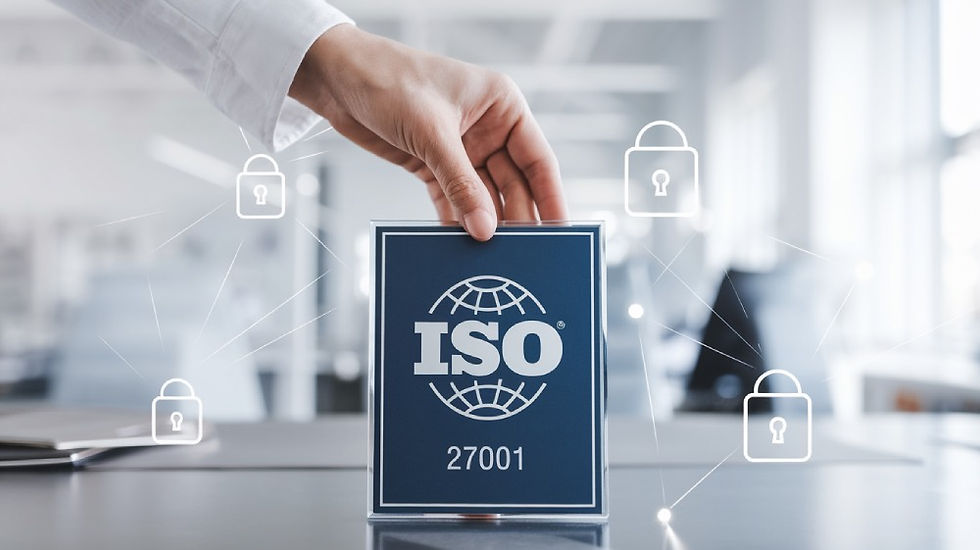What to avoid with ISO 27001 certification?
- The SOC 2

- Apr 13
- 3 min read
Updated: May 16

Achieving ISO 27001 certification requires a strategic approach and deep understanding of the standard. Many organizations stumble along this path, making mistakes that significantly complicate or extend their certification journey. Let's explore the most common pitfalls and how to successfully navigate around them when implementing an Information Security Management System (ISMS).
Relegating ISO 27001 to the IT department alone
One of the most fundamental misconceptions is treating ISO 27001 certification as purely an IT initiative. The standard demands engagement from every level of the organization – from the C-suite to frontline employees. Information security permeates all aspects of business operations, encompassing administrative processes, technical controls, and physical safeguards.
Successful implementation hinges on creating a culture where information protection becomes everyone's responsibility. Senior leadership must champion the initiative, while staff across all departments need to understand their specific role in maintaining data security. Without this organization-wide commitment, certification efforts often falter despite technical excellence.
Artificially limiting the certification scope
Another common mistake involves arbitrarily restricting the ISMS scope to simplify implementation. For instance, organizations might attempt to protect only their email system and SharePoint environment, overlooking sensitive data residing on employee laptops or in cloud services.
A robust approach aligns the scope with actual information flows within the organization. This requires methodically identifying what information needs protection, where sensitive data resides, who has access to it, and which stakeholders participate in information processing. By letting data flows define boundaries, you ensure the certification scope reflects genuine organizational needs rather than convenient but artificial limitations.
Implementing controls without thorough risk assessment
ISO 27001 is fundamentally risk-based, yet many organizations rush to implement security controls without first conducting comprehensive threat analysis. Risk assessment is the critical foundation that must precede both gap assessment and security implementation.
Rather than uncritically adopting generic templates, security controls should be carefully tailored to your organization's unique risk profile. Furthermore, the standard intentionally avoids prescribing exact implementation methods, giving you the flexibility to adapt controls to your specific circumstances and requirements.
Viewing certification as a one-off achievement
A widespread misconception treats ISO 27001 certification as a finite project with defined start and end points. Organizations frequently focus exclusively on obtaining the certificate, subsequently neglecting ongoing monitoring and compliance maintenance between annual audits.
Continuous improvement is a cornerstone of the standard, requiring mechanisms that demonstrate progressive enhancement of your security posture. This means regularly reviewing and updating policies, procedures, and controls to address evolving threats and changing business conditions. The certificate itself merely validates that your living, breathing ISMS functions properly—it's not the endpoint of your security journey.
Failing to integrate security into daily operations
Creating an ISMS that exists in isolation from everyday business processes represents another critical error. Too often, organizations develop security frameworks that look impressive on paper but remain disconnected from organizational culture and daily activities.
An effective approach requires embedding cybersecurity practices into everyday business operations. For optimal effectiveness, administrative, technical, and physical controls must be accessible and straightforward for employees to apply in their routine tasks. Only then does information security transform from an external compliance requirement into an integral part of organizational DNA.
Missing opportunities for standards integration
In today's complex regulatory landscape, organizations typically need to satisfy multiple compliance requirements. Neglecting to integrate ISO 27001 with complementary standards inevitably leads to duplicated efforts and inefficient resource allocation.
A strategic approach leverages natural synergies between related standards such as ISO 27701 for privacy management, DORA, or NIS2. Consider a cloud service provider pursuing ISO 27001 certification while planning eventual FedRAMP Authority to Operate (ATO). Through thoughtful planning, they can optimize resource utilization and streamline implementation timelines for both frameworks.
Creating documentation overload
While documentation forms an essential component of ISO 27001, many organizations produce excessively complex and voluminous documents that become impractical to maintain and follow. Effective ISMS documentation should be concise, accessible, and genuinely useful for those who need to reference it regularly.
Excessive bureaucracy frequently discourages compliance with security procedures and policies, ultimately undermining the ISMS effectiveness. Instead, strive to develop documentation that supports security objectives while remaining practical enough to serve as a valuable resource rather than a bureaucratic obstacle.
Summary
Understanding these common pitfalls significantly increases your chances of successfully implementing ISO 27001 and navigating the certification process. The key lies in adopting a holistic approach to information security that seamlessly integrates technical, administrative, and physical aspects while engaging stakeholders across the entire organization.
Remember that ISO 27001 represents far more than a certificate to display on your website or office wall—it's a comprehensive framework designed to genuinely protect organizational information assets. When properly implemented, the standard delivers tangible business benefits, enhances customer and partner trust, and substantially reduces the likelihood of serious security incidents affecting your data.







Comments